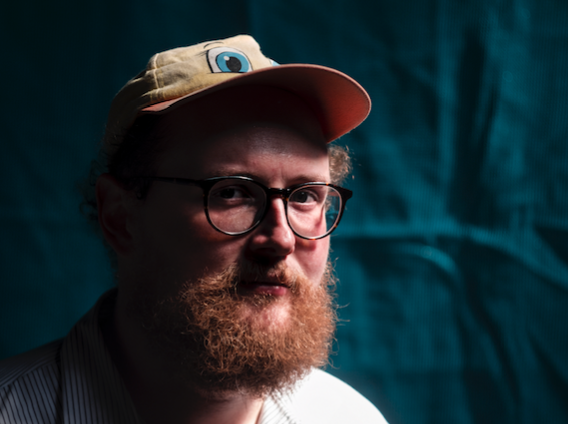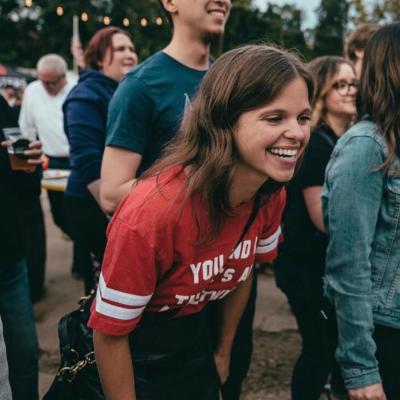
When Dan Deacon makes music, he likes to think about more than just the individual notes and their complex arrangements. These days, the local musician often finds himself bouncing between writing his signature electronic music, full-length solo albums, and intricate, acclaimed film scores—each approach influencing the way he thinks about the next, leaving him to ponder big questions.
Like, “What is the role of an album, or a concert, or a score? And how and where are people going to listen to it?” poses Deacon. “When you’re at home listening to music, it’s like furniture—it enhances the living experience. When you go to a show, it’s like theater—you’re supposed to watch and become immersed into another world. With film, the score helps keep you within a specific universe. . . . It’s like when you make a meal. You think of who’s coming to dinner, where you’re eating it, if it’s a fancy dinner or a casual get-together or a pot-luck.”
Big things to think about on the eve of a feast: his debut performance at the Joseph Meyerhoff Symphony Hall as part of BSO Pulse, the innovative concert series, now in its fourth season, that pairs indie musicians with the Baltimore Symphony Orchestra. Pulse has featured other notable performances by Baltimore acts, such as Lower Dens and Wye Oak, but as a founding father of the city’s DIY music scene, Deacon’s performance feels like the series’ pinnacle.
“Thinking about that gigantic stage, in an acoustically perfect room, how to fill out the space and find a way to utilize the seated audience in a beautiful way—it became very exciting to think about all the possibilities,” says Deacon, calling the whole thing a big experiment. “We’ll see on Thursday night.”
At the same time, for a classically trained composer who studied musical composition with a computer music concentration at SUNY Purchase in New York, performing with a full orchestra is a sort of capstone as well. The average listener might not know it, but Deacon’s music has long been influenced by his education—though “I never really had any interest in 18th- or 19th-century music”—with his early albums inspired by minimalist composers such as Philip Glass, Steve Reich, and Terry Riley, featuring both orchestral arrangements and multi-part suites. It seems as if his entire career has been building toward a moment like this—each record growing in vision and virtuosity, from exuberant party-starters to avant-garde opuses.
The Meyerhoff is a far cry from the warehouse venues that Deacon first performed upon arriving in Baltimore some 15 years ago, but he’s no stranger to hallowed stages, either, having performed at Carnegie Hall in New York and the Waterloo Symphony in Canada. (His music has also been adopted by the New York City Ballet.) But this will be the first time the musician will be sitting down to play alongside a full philharmonic orchestra.
Co-hosted by WTMD, the Pulse performance will begin with a set by the BSO (including classics by Sebastian Bach and Erik Satie and a contemporary work by Du Yun), followed by a solo set from Deacon (including a few tracks from his 2015 Gliss Riffer), concluded by a collaborative set with both acts. For the main event, Deacon will also include his own 24-person ensemble, which he has performed with in past shows and on previous records, featuring instrumental arrangements by local composer Patrick McMinn, as well as a new vocal choir, featuring vocal arrangements by Allison Clendaniel of experimental classical music collective Mind On Fire. In total, there will be more than 40 musicians on stage.
“The whole spirit of the night is about the Venn diagram of what we [Deacon and the BSO] both do while also being willing to reach into the other side,” he says. “These shows take so much work—months. You could fill a wing of the Enoch Pratt with just the emails. We’re not just showing up and setting up our equipment. Everything about this night is from the ground up.”
“Working with Dan has already been a hugely rewarding collaboration,” says associate BSO conductor Nicholas Hersh. “The [final set] will truly be the centerpiece of the show, much more extensive and integrated than in past Pulse programs. We are all ridiculously excited to take on this challenge and witness months of preparation come to fruition.”
Both locally and internationally, Deacon has become known for his infectious live shows that typically incite some sort of interactive dance-off among the audience. If you attended his performance at Space 2640 to commemorate the 10th anniversary of his debut Spiderman of the Rings in 2017, you know what we’re talking about. (If not, just watch his NPR Tiny Desk concert to see what we mean.) Of course, this creates a predicament in a 2,443-seat symphony hall that commonly draws an older crowd. That grand, gilded room will play host to only the second seated show Deacon has ever performed in Baltimore, counting the Windjammer concert with Future Islands and Beach House at Pier Six as his first.
But during their collaborative set, Deacon and the BSO will be performing “Pink Batman” and “Snookered” from 2007’s Spiderman of the Rings and 2009’s Bromst, respectively, as well as his lush four-part suite “USA” from 2012’s America and a world premiere of a new work. “To me, you’d listen to all of those pieces sitting down,” says Deacon. “I don’t want people to feel like sitting is bad. I love sitting. With 40-plus musicians on stage, there’s just going to be a lot to look at, a lot to take in. I’m just imagining myself sitting in a chair in that room, which is so rich, in and of itself, hearing that sound from the stage, and having it bounce off the walls, and the ceiling above me.”
But he hasn’t ruled anything out: “I can’t help myself. I have no idea what I’ll do.”
Since moving to Baltimore after college in 2004, when he helped found the Wham City arts collective at the Copycat Building in Station North, Deacon has fostered a sense of creative freedom and community in this city, across a wide mix of artists and genres. After seven records, international tours, and opening sets for the likes of Arcade Fire and Miley Cyrus, Deacon still calls the city home and continues to support both old friends and up-and-coming artists. Last year, he curated the lighting during an Abdu Ali show at the Metro Gallery; celebrated the release of Riddles, the acclaimed new album by local post-punk duo Ed Schrader’s Music Beat, which he co-wrote and produced; and headlined the Believe In Music Halloween party at the Maryland Science Center.
Today, he sees the local music scene much “how I’ve always seen it, which is just full of amazing, incredible talent,” he says. “It’s a really driven and diverse ecosystem. The hardest part is getting anyone from outside of town to pay attention. But I feel like that’s changing. I just wish there were more venues and opportunities for people to play in front of larger audiences . . . But that’s what makes this show so special—it opens up the door to people who wouldn’t normally be in a space like this, and I hope they continue the series and open it up to more Baltimore artists.”
That altruistic ethos is embodied in the evening’s pre-show lineup, where Deacon has asked a handful of local artists to be part of a special performance, with five solo sets by saxophone player Jamal Moore, electronic artists Amy Reid and Alex Silva, and experimental musicians Amanda Schmidt and Stewart Mostofsky taking place simultaneously in the Meyerhoff lobby starting at 7 p.m.
Of course, this performance comes just two days after the expiration of the BSO’s contract negotiations between players and the administration, which aims to reduce the symphony’s schedule, effectively eliminating the summer season and decreasing musician salaries. The move has the potential to demote the “full-time, world-class orchestra into a part-time regional orchestra,” according to a statement from the musicians.
“I just want to state that I back the players entirely and support what they are putting themselves on the line for,” says Deacon. “Imagine if the Baltimore Museum of Art closed for a significant portion of the year, having wings closed and the art shifted out. When you think about it in any other context, it’s clearly a massive mistake. Imagining Baltimore without the BSO would be a shame.”
For him, after the show, he’s back to work, finishing up two more film scores and a new record—his eighth—by this spring. But for now, he’s looking forward to Thursday night, to the very moment when the show begins.
“The whole point is to be completely and utterly present—to kind of forget that time is moving,” says Deacon, an artist whose mind is in constant motion—thinking, assessing, reassessing, connecting dots, breaking them apart again—a visionary composer, and a benevolent conductor of the Baltimore music scene after all these years. “Much of the show will be the orchestra and the ensemble and all the players, so I can step back a little bit more than usual and just be.”
